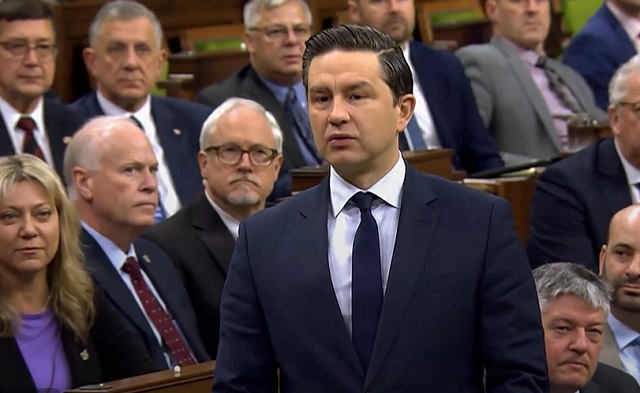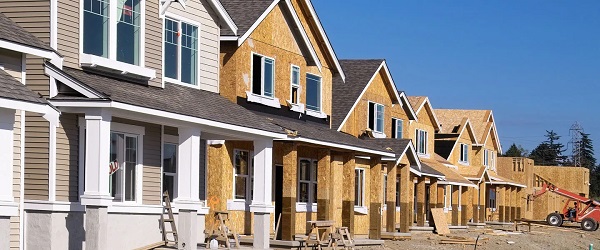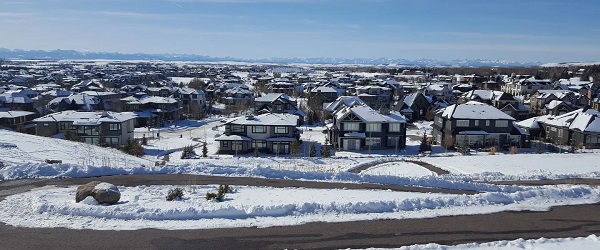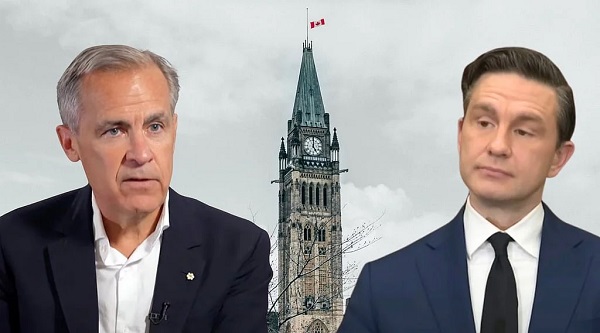Housing
Conservative leader Pierre Poilievre’s video on Canada’s housing crisis under Trudeau gov’t goes viral

From LifeSiteNews
‘Housing hell: How we got here and how we get out’ has been viewed more than four million times.
A video by Conservative Party of Canada (CPC) leader Pierre Poilievre exposing the country’s housing prices and supply crisis, which a taxpayer watchdog said is being fueled by high-interest rates from bad fiscal policy by Prime Minister Justin Trudeau’s government, has reached over 4 million views.
“Something new and strange has happened in Canada. Canada is sitting on probably one of the largest housing bubbles of all times, something we haven’t seen before,” Poilievre said in his 15-minute video titled Housing hell: How we got here and how we get out.
“An entire generation of youth now say they will never be able to afford a home. This is not normal for Canada.”
Housing hell: How we got here and how we get out. pic.twitter.com/vVLsXMVM35
— Pierre Poilievre (@PierrePoilievre) December 2, 2023
The video goes deep into Canada’s housing market and includes statistics on why it is in such a dire state. It currently has 4.2 million views on X (formerly Twitter) after it was released on December 2.
Poilievre documents in his video, using facts to back him up, that in the coming months and years “tens of thousands of Canadians could default on their mortgages” due to skyrocketing interest rates.
He noted how the “nightmare scenario” after “generations of affordable and stable Canadian home prices” means that 66% of a person’s average monthly income is to simply “make payments on the average single detached Canadian house.”
“Given that most of the remaining 34 percent of the family paycheck is taken out by taxes, there’s literally nothing left for food and recreation,” Poilievre noted.
Taxpayer watchdog says high house prices due to Trudeau’s out of ‘control’ government
Franco Terrazzano, federal director for the Canadian Taxpayers Federation (CTF), told LifeSiteNews that the reason house prices, along with everything else, are more expensive is due to Trudeau’s “out of control” governmental spending.
“Trudeau’s never-ending deficits and the hundreds of billions of dollars the Bank of Canada printed during the pandemic are driving up the cost of everything,” Terrazzano told LifeSiteNews.
“Life is more expensive because the cost of government is out of control.”
Terrazzano noted that governmental fiscal policy is making home prices more expensive and thus out of reach for most. He said what needs to happen is a reduction in red tape.
“Taxes and onerous government regulations are making homes more expensive,” Terrazzano told LifeSiteNews.
“If governments want to make homes more affordable, they would cut taxes and the red tape that makes it harder and more expensive to build homes.”
Terrazzano highlighted a report from the C.D. Howe Institute that shows the cost of excessive government regulations on home building.
As for Poilievre, he observed how it now would take a staggering 25 years just to save enough money to make a downpayment for a simple home in Toronto.
He continued, noting how newlyweds now on average pay $1,000 per month to rent a “single room in a townhouse that they share with two other couples.”
He also raised the issue of how 35-year-olds “live in their parent’s basements” and “rents are so high in Toronto that students live in homeless shelters.”
When it comes to middle-class workers, Poilievre emphasized how “people like nurses and carpenters now live in their vehicles.”
While housing falls primarily under provincial and municipal jurisdiction, some areas, such as interest rates, are directly influenced by the federal government.
House prices have shot up in Canada due to short supply in the market, and speculative buying and interest rates have risen to highs not seen for decades. As it stands, Canada’s interest rate sits at 5%. At this same time in 2021, interest rates were 0.25%.
This past Wednesday, the Bank of Canada decided to keep rates at 5% but did not rule out future rate increases, as it “is still concerned about risks to the outlook for inflation and remains prepared to raise the policy rate further if needed.”
Interestingly, Trudeau put out a video the same day as Poilievre that he said was to address housing challenges. This video only has 264,000 views, however.
Curiously, Poilievre made no mention of Canada’s high immigration levels, which critics say has put a strain on an already tight supply.
Maxime Bernier, leader of the People’s Party of Canada, has been one of the only party leaders to call out high immigration levels and their effects on housing.
Trudeau’s ‘money printing’ pouring fuel on ‘inflationary fire’
According to Poilievre in his video, in the past one could save enough to buy a house by their mid-20s but said this “changed” about “eight years ago” when Trudeau came to power.
“When the government borrows and spends, it builds up the goods we buy and the interest we pay. The Trudeau government has doubled Canada’s debt, adding more debt than all prime ministers combined. Our finance minister has conceded that this deficit spending pours fuel on the inflationary fire,” Poilievre said.
He observed how excessive money printing through a banking scheme called “quantitative easing” has only benefited well-connected banking insiders and financial institutions that are awash with money.
“In recent years, the Trudeau government spending has exploded, and they’ve been borrowing more than lenders will lend. So, the Bank of Canada has started creating the cash. The money supply has therefore grown eight times faster than the economy over the last three years,” Poilievre said.
“More money bidding on fewer goods, including fewer houses, equals higher prices.”
Poilievre ended his video by stating that the “good news is housing costs were not like this before Justin Trudeau.”
“And they won’t be like this after he’s gone,” he added.
He said that the solution, besides a change in leadership, is for all levels of government to work together to cut red tape and taxes to encourage the construction of new homes.
Under Trudeau, mainly due to excessive COVID money printing, inflation has skyrocketed.
A recent report from September 5 by Statistics Canada shows food prices are rising faster than headline inflation at a rate of between 10% and 18% per year.
Earlier this year, the Bank of Canada acknowledged that Trudeau’s federal “climate change” programs, which have been deemed “extreme” by some provincial leaders, are indeed helping to fuel inflation.
Business
The numbers Canada uses to set policy don’t add up

This article supplied by Troy Media.
 By Roslyn Kunin
By Roslyn Kunin
Canada’s biggest policy mistakes come from treating complex systems as simple math
Here is an old story with a valuable message. In the directed economy of the USSR, it was the government, not markets, that decided what and how much was to be produced.
Take metalware for the kitchen: mugs, mixing bowls, pots, pans, dishpans and washtubs. The government decided how much people needed and ordered the industry to produce that many tons at the lowest possible price.
Quotas were met, the appropriate tonnage was produced and costs were controlled. But no mug, pot or dishpan was to be found. The industry found that the easiest way to meet its cost and quantity requirements was to produce nothing but washtubs.
It is a valuable reminder today for Canada: when policymakers rely on a single number to steer complex systems, they almost always get the wrong results.
There are at least three reasons why we need better analysis in policymaking. The first is that the things inside a total number are not all the same. Mugs and washtubs are not interchangeable.
The second is unintended consequences. How did devoting metal to domestic products affect other metal-using sectors like automobile production? The same pattern appears in modern Canadian policy: shifting one number often disrupts systems we depend on elsewhere.
Third, picking a number to solve a problem is often an easy way to avoid doing a rigorous cost-benefit analysis that would offer a clear indication of the overall effectiveness and impact of any decision. Too often, our debates jump straight to targets instead of evidence.
We like to think that policy decisions in Canada are decided on more than just picking a magic number and waiting for it to solve a problem. That is not always the case. Policies for both the housing market and labour market could benefit from more detailed analysis.
Canada faces a severe housing shortage, not only in the major cities, but also in smaller centres as people move there from metro areas and push up home prices. One-number thinking has led the government to drastically cut back the number of people coming into Canada on a permanent or temporary basis believing that thousands of fewer new arrivals will make available thousands more housing units.
This is not likely, especially when considering temporary workers. Many of these are international students. The number of housing units freed by their absence is significantly lower than the reduction in student visas issued. Many students stay in dorms or other student housing. Others crowd together in apartments or houses to save costs. Not much housing is freed to deal with the shortage.
One serious unintended consequence of cutting back student visas is the negative impact on educational institutions which have been relying on the generous fees that foreign students pay to deal with the constrained fees and limited funding imposed on them by governments.
Cutting back on the number of temporary foreign workers (TFWs) will also have a minimal effect on the supply of housing in the major centres where shortages are most severe. TFWs are most needed in industries like agriculture and in smaller centres where their absence will be sorely felt.
Looking at the labour market, it is unrealistic to expect unemployed Canadians to fill these job gaps. People in major cities rarely move to remote areas to take lower-paying work. Cutting back TFWs will harm the sectors and places that rely
on them. Differences in geography, occupations and preferences ensure that workers are not interchangeable.
Homes are not interchangeable either. They have to be in the places where people choose to live, and they have to be affordable. In many places like Vancouver, the actual and potential number of homes is enough to house everyone who needs one, especially if the development permits now being sought result in actual construction. But in cities like Vancouver and Toronto, the benchmark price of a home has risen far faster than wages for more than a decade, making many new units unaffordable even when supply increases.
Builders are now having trouble filling existing units because they did not pay enough attention to affordability. The cost of producing a housing unit is higher than what most Canadians can pay, even after the size of a home has shrunk below what most Canadians are used to. As a result, builders are lowering prices and rents and offering other inducements to potential residents. Builders are now lowering prices and rents and/or offering other inducements to potential residents.
Let us hope that our educational institutions will be able to produce, and our immigration policies will allow us to admit, qualified people who can develop and implement policies based on more than one number.
Canada needs decisions grounded in reality, not wishful targets.
Dr. Roslyn Kunin is a respected Canadian economist known for her extensive work in economic forecasting, public policy, and labour market analysis. She has held various prominent roles, including serving as the regional director for the federal
government’s Department of Employment and Immigration in British Columbia and Yukon and as an adjunct professor at the University of British Columbia. Dr. Kunin is also recognized for her contributions to economic development, particularly in Western Canada.
Troy Media empowers Canadian community news outlets by providing independent, insightful analysis and commentary. Our mission is to support local media in helping Canadians stay informed and engaged by delivering reliable content that strengthens community connections and deepens understanding across the country.
Alberta
Calgary mayor should retain ‘blanket rezoning’ for sake of Calgarian families

From the Fraser Institute
By Tegan Hill and Austin Thompson
Calgary’s new mayor, Jeromy Farkas, has promised to scrap “blanket rezoning”—a policy enacted by the city in 2024 that allows homebuilders to construct duplexes, townhomes and fourplexes in most neighbourhoods without first seeking the blessing of city hall. In other words, amid an affordability crunch, Mayor Farkas plans to eliminate a policy that made homebuilding easier and cheaper—which risks reducing housing choices and increasing housing costs for Calgarian families.
Blanket rezoning was always contentious. Debate over the policy back in spring 2024 sparked the longest public hearing in Calgary’s history, with many Calgarians airing concerns about potential impacts on local infrastructure, parking availability and park space—all important issues.
Farkas argues that blanket rezoning amounts to “ignoring the community” and that Calgarians should not be forced to choose between a “City Hall that either stops building, or stops listening.” But in reality, it’s virtually impossible to promise more community input on housing decisions and build more homes faster.
If Farkas is serious about giving residents a “real say” in shaping their neighbourhood’s future, that means empowering them to alter—or even block—housing proposals that would otherwise be allowed under blanket rezoning. Greater public consultation tends to give an outsized voice to development opponents including individuals and groups that oppose higher density and social housing projects.
Alternatively, if the mayor and council reform the process to invite more public feedback, but still ultimately approve most higher-density projects (as was the case before blanket rezoning), the consultation process would be largely symbolic.
Either way, homebuilders would face longer costlier approval processes—and pass those costs on to Calgarian renters and homebuyers.
It’s not only the number of homes that matters, but also where they’re allowed to be built. Under blanket rezoning, builders can respond directly to the preferences of Calgarians. When buyers want duplexes in established neighbourhoods or renters want townhomes closer to work, homebuilders can respond without having to ask city hall for permission.
According to Mayor Farkas, higher-density housing should instead be concentrated near transit, schools and job centres, with the aim of “reducing pressure on established neighbourhoods.” At first glance, that may sound like a sensible compromise. But it rests on the flawed assumption that politicians and planners should decide where Calgarians are allowed to live, rather than letting Calgarians make those choices for themselves. With blanket rezoning, new homes are being built in areas in response to buyer and renter demand, rather than the dictates of city hall. The mayor also seems to suggest that city hall should thwart some redevelopment in established neighbourhoods, limiting housing options in places many Calgarians want to live.
The stakes are high. Calgary is not immune to Canada’s housing crisis, though it has so far weathered it better than most other major cities. That success partly reflects municipal policies—including blanket rezoning—that make homebuilding relatively quick and inexpensive.
A motion to repeal blanket rezoning is expected to be presented to Calgary’s municipal executive committee on Nov. 17. If it passes, which is likely, the policy will be put to a vote during a council meeting on Dec. 15. As the new mayor and council weigh changes to zoning rules, they should recognize the trade-offs. Empowering “the community” may sound appealing, but it may limit the housing choices available to families in those communities. Any reforms should preserve the best elements of blanket rezoning—its consistency, predictability and responsiveness to the housing preferences of Calgarians—and avoid erecting zoning barriers that have exacerbated the housing crisis in other cities.

Austin Thompson
-

 Health2 days ago
Health2 days agoCDC’s Autism Reversal: Inside the Collapse of a 25‑Year Public Health Narrative
-

 Crime2 days ago
Crime2 days agoCocaine, Manhunts, and Murder: Canadian Cartel Kingpin Prosecuted In US
-

 Health2 days ago
Health2 days agoBREAKING: CDC quietly rewrites its vaccine–autism guidance
-

 National2 days ago
National2 days agoPsyop-Style Campaign That Delivered Mark Carney’s Win May Extend Into Floor-Crossing Gambits and Shape China–Canada–US–Mexico Relations
-

 Energy2 days ago
Energy2 days agoHere’s what they don’t tell you about BC’s tanker ban
-

 Daily Caller2 days ago
Daily Caller2 days agoBREAKING: Globalist Climate Conference Bursts Into Flames
-

 Bruce Dowbiggin1 day ago
Bruce Dowbiggin1 day agoBurying Poilievre Is Job One In Carney’s Ottawa
-

 Great Reset1 day ago
Great Reset1 day agoEXCLUSIVE: A Provincial RCMP Veterans’ Association IS TARGETING VETERANS with Euthanasia






